Please again welcome Powered Sport Flying publisher, Roy Beisswenger, who sent the following story on the exciting new powered parachute from SkyRunner. —DJ
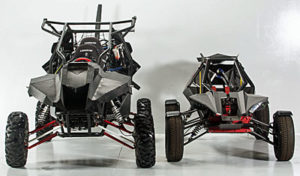
SkyRunner has evolved significantly. The current version is on the left; the original prototype is on the right. Size, seating, power plants, instrumentation, wing, chassis… nothing is the same.
I have been actively following SkyRunner for more than a year. The U.S. start-up company is rare in the Light-Sport world. The company’s MK 3.2 entry is the first American two-seat powered parachute manufacturer to launch since the LSA regulation was issued.
Sadly, the SP/LSA rules actually ran most of the powered parachute manufacturers, dealers, instructors, and even pilots from the early 2000s out of the business and sport. It is refreshing to watch a company buck that trend!
Creating a powered parachute from the ground up is a challenge, and to build one that doubles as mighty gnarly all-terrain vehicle is even more of a challenge. SkyRunner’s team did it more than once. They began their effort with a single-place model (photo) that owner and developer Stewart Hamel initially funded. The single-place edition was designed and prototyped in the United Kingdom and was to be sold here in the USA.
Hamel quickly found that the market was less interested in that aircraft and more interested in a two-place version of the powered parachute. For that and other business reasons, he brought the design work from the UK to his home town of Shreveport, Louisiana and took a more hands-on approach to development.
Features for the powered parachute were essentially “crowdsourced” with SkyRunner listening closely to what potential customers wanted. Then the military got wind of it because of its potential as a special operations platform. However, the list of features that the military was interested in was more than the typical civilian’s “roll out, warm up, take off, and fly” mission profile.
What special forces operators really wanted was an aircraft that can fly, but also act as a ground tactical vehicle. They also wanted it to be multi-terrain. They wanted more payload. Since the goal was to take the aircraft into battle (or even deep behind the battle), they wanted reliability. SkyRunner MK 3.2 delivers!
Satisfying the military and first-responder wish lists makes the SkyRunner an aircraft that appeals to adventurous civilians, too. So instead of turning his focus to a “government only” design, Hamel worked from the outset to make a product that also conforms to the FAA’s SLSA standards. SLSA regs — and a weight exemption similar to ones issued for the Terrafugia and Maverick flying cars — make it possible to offer the SkyRunner to the public.
While new to manufacturing, and certainly to aircraft manufacturing, Stewart is not new to business or parachutes.
He was involved in successful startup companies in the past such as ReachLocal (once a $800 million company), he understood business fundamentals well. When I visited his facility early in 2015, I was very impressed. The factory he was in was absolutely huge, being an old AT&T pay phone factory. Instead of renting the whole space, though, he only leased and fenced off a tiny fraction of the cavernous facility. As production ramps up, SkyRunner won’t have to move. Stewart will simply lease more floor space and move the fence.
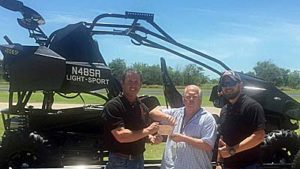
Getting their pink Special Airworthiness Certificate. Shown are Stewart Hamel, CEO & Founder; Doug Leinberger FAA Air Safety Investigator from the Ft. Worth MIDO; and, Cody Lackey, Director of Production for SkyRunner.
Stewart’s experience under canopies came from skydiving. Once an avid jumper, a bad accident and injuries in the sport prompted his doctors to encourage a new hobby. After some looking around, Hamel found powered parachutes and pursued his new sport with a passion.
One of the lessons learned during the development process was what to build in-house and what to outsource. Initially Stewart wanted to outsource all he could and do only final assembly at his facility. During the prototyping and development work, he found that it was easier to control quality and get things done faster if he did more work in-house.
Now with initial development complete, current plans now are back to only to doing the final assembly at their Shreveport facility. “We are having the welded chassis and wiring harnesses outsourced,” Hamel said. “For final assembly, a team of four can complete eight to ten SkyRunners per month,” he added. “That makes production scalable. As we grow, we can bring in additional teams of four to increase production.”
Any pilot (or ATV enthusiast) wonders how SkyRunner performs.
This is actually two questions since MK 3.2 is both ground vehicle and aircraft. I only have experience with it on the ground, and I have to say that it is a thrill ride. With its wide wheelbase, light weight, and Polaris motor, SkyRunner will go places and do things that you’d never try with normal ATVs. Yes, you read that right. It has a dedicated Polaris motor for ground operations, making it an off-road bandit.
SkyRunner also has a Rotax 912. As a powered parachute MK 3.2 takes off like any other powered parachute, only easier. Four wheels, that wide wheel base, and a low center of gravity combine to make the SkyRunner almost immune to tipping over.
It also seems that the ground motor could also have a function for takeoff. Kiting (getting the parachute inflated and above the chassis) is one of the most challenging tasks for the new powered parachute pilot. Kiting in light and variable wind is even more of a challenge. If the wing comes up crooked or slides to one side, the parachute lines or risers could get caught in a spinning prop. Let it go too far and you can tip some powered parachute carriages.
With a separate ground engine, a pilot wouldn’t have to turn a prop to roll forward enough to kite the parachute. As the wing rises, the four-wheeled cart can handle most any odd kiting weirdness, and when you are happy that the wing is where it belongs, you can start the prop engine for actual take-off and climb. This isn’t the official text book takeoff procedure, but it appears to hold promise.
Now with the their newly awarded SLSA airworthiness certificate, SkyRunner is kicking things into high gear. While it hasn’t been a secret that they exist, they haven’t aggressively promoted their product to the aviation community… yet. Nonetheless, they have delivered a couple aircraft overseas to impatient customers while working through FAA paperwork.
With the design settled and the production facility in place, deliveries are going to start taking place in the U.S. The approved design is now something that the military and other agencies can test and see if it suits their purposes. Expect to see a lot more out of this company this summer and in the future. Congratulations to Stewart Hamel and his entire crew!


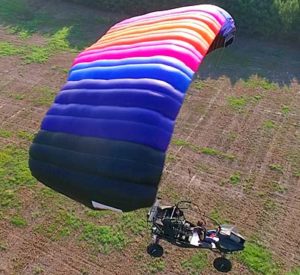
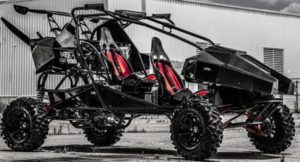
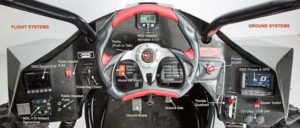
I want one!
Exciting innovative technology, easy to see military application price will dictate private acceptance